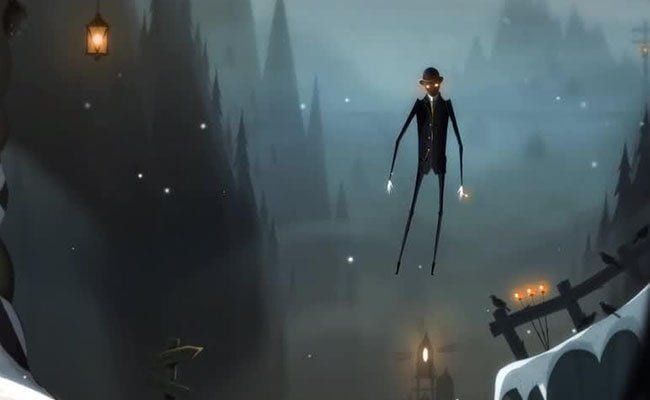
Thomas Brush excels at creating worlds.
I first encountered Brush’s work some number of years ago at Newgrounds. I found his two short platformers Coma and Skinny especially compelling because of the strangeness of their worlds and the quirkiness of these games’ overall sensibilities.
Each of them are often both whimsical and haunting in equal measure, and his full-length follow-up to those initial Flash games, the recently releasedPinstripe, shares that same quality.
Like Brush’s other games, Pinstripe seems interested in transitions from one state of awareness to another. If Coma and Skinny both concern sleep and waking, Pinstripe is more concerned with the dawning of revelation and the possibility of reaching a redemptive state. In that regard, there’s a change in some of Brush’s presentation from the ambiguously symbolic to a more straightforwardly told allegory. While a player walking away from Coma and Skinny may come away with a sense of the obscurity of many of Brush’s symbols and characters, Pinstripe reveals its purpose and themes quite clearly by the time that it’s over.

Brush borrows here one of the most common tropes of video games, the need to rescue the girl, in his story of a father who chases down a strange and sinister figure called Pinstripe who has abducted his daughter, Bo. While love may be a motivating factor for this mission, this iteration of “saving the princess” is not characterized by romantic interest, of course, but instead by the love of a father for his daughter — and, perhaps, the obligation that entails. That obligation becomes more apparent as the backstory of Ted, the game’s protagonist and a former minister, is fleshed out, and his need for proving himself as a good father and protector becomes altogether clearer.
As noted before, though, Brush’s real talent is in creating compelling worlds through a marriage of whimsical and haunting images and sounds. Pinstripe‘s version of Hell, which is the landscape where the game takes place, is more often weird and curious than it is horrifying. It’s populated by odd characters with strange motivations and bizarre charms.

The gameplay itself involves some mild puzzling and mild platforming. Like his other games, the mechanics themselves are minimal. As a result, the game is easy to pick up and has a breezy pacing and difficulty.
The game is worth playing simply for the sake of seeing what odd new character or places Brush will present next to the player. Brush has a knack for representing the intriguingly strange through his unusual visuals and through unexpected dialogue and just plain, old moments of oddity and the absurd.
Pinstripe is a more polished and complete work than anything that Brush has created to date, and I hope that it foreshadows his continued commitment to the creation of lovely strange worlds.


![Call for Papers: All Things Reconsidered [MUSIC] May-August 2024](https://www.popmatters.com/wp-content/uploads/2024/04/all-things-reconsidered-call-music-may-2024-720x380.jpg)



